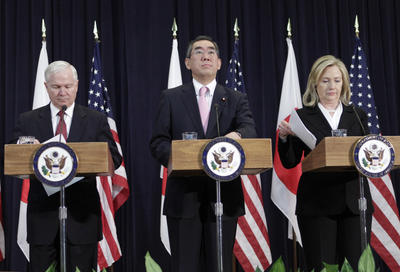Now comes the news, from a 21 June meeting of the US-Japan Security Consultative Committee, that Washington and Tokyo are promoting trilateral strategic dialogue with India. The three countries already conduct the Malabar military exercise. Now, they aim to expand their cooperation through enhanced diplomatic and strategic coordination.
Don’t get me wrong: such coordination is commendable and necessary. And the US, Japan and India certainly have common strategic interests in Asia, as well as a growing array of shared interests globally.
But, by my count, this new trilateral will join a confusing welter of at least four existing Asian trilaterals: US–Japan–South Korea, China–Japan–South Korea, US–Japan–Australia, and China–India–Russia. In Washington, there remains lingering talk of a US–China–Japan trilateral. And sentiment remains among some for a quadrilateral bringing together the United States, India, Japan and Australia.
Perhaps it’s time to ask a few elemental questions: for one, is there a functional purpose to all this redundant and overlapping geometry? What is unique to any of these groups of three or four that would enable enduring solutions to the most pressing security, economic, or transnational problems?
To see this in stark relief, consider the proposed US–China–Japan group. It cuts out the other principal US ally in Northeast Asia, South Korea. It risks irrelevance if it ducks the hard issues, such as competing Chinese and Japanese territorial claims, Japanese concerns about China’s military posture, and Chinese suspicions about the US-Japan alliance and missile defence. And it will create frustration or even increased tension if it does try to delve into such tough issues. Such a group will grope for purpose. And it is not obvious what issues or capabilities are unique to these three actors and do not already exist in other multilateral forums.
So therein lies the problem: a more effective and purposeful multilateralism would begin with lessons learnt. Neither Asia nor the world lacks a history of successful multinational coordination. But especially since the end of the Cold War, the most successful multilateral groups have been ad hoc and informal, mobilising specific coalitions to address specific issues, imminent problems and immediate crises.
Crisis has tended to be the catalyst of such successful multilateral ventures. But Asia’s redundant existing mishmash reflects an underlying assumption that dialogue and process are beneficial in and of themselves. Thus geometries have been created, only to grope for missions and functions.
At some level, this reflects the liberal-institutionalist view that well-functioning institutions in themselves can mediate problems and ambitions. But recent experience, certainly in Asia, suggests that institutions are only as useful as the major powers are invested in them. The prevailing approach has devalued most of Asia’s existing architectures while doing little to foster a more effective one. In every crisis of recent years, the most effective global and regional problem-solving has been borne of necessity and focused on results.
The most successful groups have assembled quick-moving countries, animated by the urgency of crises. They combine interest, resources and expertise. They eschew the big international security questions that so preoccupy think tanks and academe. They are unencumbered by ritualistic institutions and attendant bureaucracies. And they focus on discrete, often imminent problems.
Consider the Tsunami Core Group, through which the United States, India, Japan and Australia provided rapid and effective relief around the Indian Ocean for nine days in 2004 and 2005. As former Undersecretary of State Marc Grossman has put it, the Core Group ‘was an organisation that never met in one of diplomacy’s storied cities, never issued a communiqué, never created a secretariat, and took as one of its successes its own demise’. The group was effective precisely because it was ad hoc: Its members ‘could spend serious money to deploy capable and sustainable forces to deal with crises’.
I suppose the good news, then, is that the members of the proposed US–Japan–India group have some foundation upon which to build. Their trilateral will also grope for purpose. But at least these three countries have demonstrated that they have some capacity to first identify a functional problem and then assemble the right group of players.
Still, the larger lesson is straightforward: avoid geometry for its own sake. Form should follow function, and any multilateral group in Asia is more likely to be effective if it assembles those with the greatest power and capacity and has a clear, agreed purpose.
And that will be the real test for Washington and New Delhi: in this new group — or in international architectures, more generally — can they work together to break the cycle through which form, not function, has been the principal driver of so much multilateralism? Asia, in particular, has seen a good deal of hollow process, driven by bureaucratic inertia or path dependence: groups are formed, ritualistically meet, ritualistically issue statements, and then ritualistically persist.
The reality is that durable and effective groupings are more likely to emerge from demonstrated common purpose than from abstract geometry. As India emerges as a bigger player in Asian and global architectures, Washington and New Delhi need to ensure that process does not remain an end in itself.
Evan A Feigenbaum is Adjunct Senior Fellow for East, Central, and South Asia at the Council on Foreign Relations.
This article first appeared in the Business Standard on 27 June 2011.

